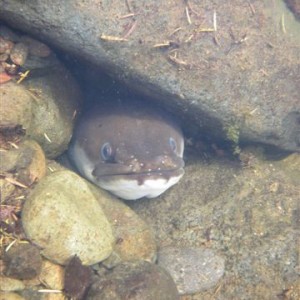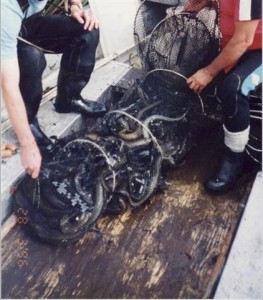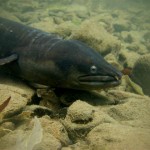Extinction Crisis
A dire situation
 The longfin eel (tuna) is now classified by the Department of Conservation as “chronically threatened in gradual decline” 1, and is thus in the same category as the Great Spotted Kiwi, NZ Falcon and Kereru (wood pigeon).
The longfin eel (tuna) is now classified by the Department of Conservation as “chronically threatened in gradual decline” 1, and is thus in the same category as the Great Spotted Kiwi, NZ Falcon and Kereru (wood pigeon).
A predicted further decline of 5-30% in the total population is predicted in the next 10 years and that decline is predicted to continue beyond the 10 year timeframe. 2.
The declining numbers of Longfin eels is typical of what is happening to populations of freshwater eels worldwide. Eel populations everywhere are collapsing at an alarming rate due to habitat loss and overfishing.
Don Jellyman, who leads NIWA’s research on freshwater fish and fisheries and is a specialist area is on the biology of freshwater eels , has listed the following as Significant negative change in national status of Longfins in his chapter “Forty Years On’ the Impact of Commercial Fishing on Stocks of New Zealand Freshwater Eels” in “Eels on the edge” Published by the American Fisheries Society May 2009
- reduction of juvenile eels size
- abundance, reduction in size of eels in commercial fishery,
- Catch per unit effort
- reduction in migrating adults
- lack of access up and down hydro dams- 10% of north island rivers and 22% of south island are above dams and so are lost habitat for longfins
- significant negative local change in sex ratios from commercial fishing
Widespread concerns that the endemic longfin eel has been overexploited have led to a recent acknowledgement by fishery mangers that current levels of exploitation are not sustainable [Ministry of Fisheries, Science Group (Comps), 2006]. Despite the additional gazetting of reserve areas, it is considered unlikely that such measures will be sufficient to arrest a predicted substantial decline in recruitment of this species. Don Jellyman (2007)
Alarming Evidence of declines
 Trap and transfer operations at some hydro dam sites in recent years have revealed that the number of longfin elvers moving up our rivers nowadays is very low – at least a 75% reduction – in stark contrast to the huge elver runs that were witnessed prior to the 1960s. Commercial catch records reveal a trend of decreasing size of all eels caught, most (in 2007, 96% in the heavily fished Waikato River, 50% nationwide) now being within the lowest size category (220 – 500g). Very few large longfin eels are now seen anywhere. Since the early 1990s the commercial harvest of eels has halved due to this rapidly declining population3.
Trap and transfer operations at some hydro dam sites in recent years have revealed that the number of longfin elvers moving up our rivers nowadays is very low – at least a 75% reduction – in stark contrast to the huge elver runs that were witnessed prior to the 1960s. Commercial catch records reveal a trend of decreasing size of all eels caught, most (in 2007, 96% in the heavily fished Waikato River, 50% nationwide) now being within the lowest size category (220 – 500g). Very few large longfin eels are now seen anywhere. Since the early 1990s the commercial harvest of eels has halved due to this rapidly declining population3.
Our concern is that very few mature eels are now making it to reproductive maturity with the result that there are now fewer elver recruits. Regularly fished rivers now show longfin eel ratios of up to 100 males to 1 or 2 females. A recent sample of longfins from a South Island river (the Aparima River) showed that 466 were male and only 5 female4. This will have obvious implications on the number of females present in future spawning populations5. Don Jellyman (NIWA) has warned that given the long generation times of this species, it may be many years before we know what the full effects of habitat loss and over-fishing are.
Reasons for the situation
The two main reasons for this extinction crisis are habitat loss and overfishing. However there are a variety of factors that enhance the problematic situation.
Commercial Take
Commercial harvesting, predominantly for export, is acting as a “nail in the coffin” for a species already decimated by habitat loss and degradation for the decline of eels6. Prompted by concerns regarding declining numbers of eels, in 2000 the South Island eel fishery was drafted into the Quota Management System, followed by the North Island in 2003 and the Chatham Islands in 2004.
Commercial Interest in eels didn’t take off until the 1960’s, and in 1975 eels were the most valuable fish export peaking at around 2500 tonnes caught. Since then, longfin eel catch numbers have continued to decline, and by the 1980s-90s this fell to 1200-1400 tonnes. Nationwide, there have been some areas where there was also a marked decline in the average size of the eels caught7.
The minimum weight of an eel which commercial eelers are permitted to take is 220 grams. However, “to get to the age where they can breed, they have to avoid commercial nets for about 30 years. Their chances of doing that aren’t good.”8 The current national TACC (total allowable commercial catch) for longfins (for 2010-2011) is set at 82 tonnes9 (Ministry of Fisheries). Under the ‘Sealords deal’ 1992, Maori automatically are granted 20% of all fisheries, however some iwi/hapu (such as Ngati Raukawa ki te Tonga), concerned with the decline of the species, do not utilise this allowance. Iwi/Maori also have customary take rights for occasions such as hui and tangi (this is currently set at 47 tonnes, and 33 tonnes for recreational fishers).
Maori Commercial Interests
Eel are a very valuable taonga for Maori, and as well as the high cultural value, they also hold a high commercial value for many iwi. However, this is a complex situation as Maori were excluded from this industry until the 90’s, when they were given a share of an already pillaged population.
Joseph Potangaroa of Rangitane o Wairarapa (Masterton) states that “our people, as with other hapu and iwi, find themselves by necessity being a part of the answer to an obvious problem although they were not a part of creating the problem i.e. the 1960s onwards. Since Sealords in the 1990s they have been players but still have pulls in opposite directions. These are some of the complexities of iwi and hapu in this neck of the woods.”10
Habitat Loss and Land-use Changes
Another key issue is habitat loss due to land use changes and development, including wetland drainage, the construction of dams, irrigation schemes, river diversions and culverts. Hydro-dams are a particular problem as they interfere with the migration pathways of eels. One estimate suggests that hydroelectric dams have blocked the longfin eel’s access to the sea in 35% of its habitat. Some dams have special passes, allowing a small number of elvers to get round the massive concrete walls, however unimpeded eel access is still crucial11. Ninety percent of pre-European wetlands have now been drained, and around 70% of pre-European forest has been removed, all radically affecting the habitat of the eel.
An example of serious habitat loss in the Wairarapa, Joseph Potangaroa
We have two literally huge examples of habitat loss- Lake Wairarapa wetlands being drained and Te Tapere Nui O Whatonga (The seventy mile bush) being cleared except for Pukaha Mt Bruce. But despite the destruction from the 1870s onwards both still supported healthy eel populations – that is until commercial fishing started. Both maori and pakeha elders agree upon this. A bit of light at the end of the tunnel is that I know a few farmers around where we live who no longer give commercial fishermen permission to fish because the farmers themselves have noticed the damage done. Infact nowadays these same people feed remaining eels, some fence off streams or leave the fish in peace.
Pollution
Eel populations are also impacted by pollution. Eutrophication from sewerage and effluent and fertilizer runoff from farms and industry can remove large quantities of oxygen from the water, meaning the eels will either die or move away 12. Cattle entering streams is a major invasion of an eel habitat and contributes to bank erosion and siltation of streams as well as pollution from faeces. The growth of exotic forest (pine) plantations has led to a rise in tannic acid runoff. Urban impacts on natural waterways have also added to the deterioration of water quality, these impacts include industrial pollution, road runoff, storm water, herbicides, domestic cleaners and fertilisers13.
Recreational Impacts
Fishing enthusiasts of introduced species and acclimatisation societies undertook intensive eel extermination campaigns during the 1940s and 50s to encourage the spread of trout and salmon populations using the fact that eels were eating juvenile sport fish as justification14. As late as the 1960s a bounty for dead eels was still paid by the Southland Acclimatisation Society. Hunting clubs have traditionally had a biggest eel competition for junior members, although some local clubs have now ceased this practice as a result of learning the true status and ages of longfin eels. Tuna were also identified by some as a predator for little mallard ducklings and people were encouraged to kill eels. Current fisheries regulations restrict recreational fishermen to catching six eels a day per person although these limits are rarely, if ever enforced.
Ocean Currents
A less tangible impact involves the role played by ocean currents and the general quality of conditions in the ocean, influencing the survival rates of larval eels and the return rates to freshwater. Climate change influences therefore provides another threat to eels15.
Ineffective Government Policy
Government policy has provided no active protection for the longfin eel, and some would argue they have only made matters worse.
In 20.. The Westland Conservancy of the Department of Conservation issued three five-year concessions for a commercial take of eels within DoC-protected land on the West Coast16.
Fish and Game (previously the Acclimatisation Society) also report directly to the Minister of Conservation and “…both agencies work closely together on matters of common interest such as the protection of freshwater habitats”17 – in other words the government agency (DoC) which is supposed to protect native fauna is working with an agency dedicated to promoting introduced game species – surely a conflict of interest?
The Ministry of Fisheries (MFish) is responsible for setting the rules around the catching of our fish. MFish states that it is “committed to ensuring that our use of this (eel) fishery by any sector is sustainable over the longer term” and agrees that the number of large eels is declining, but says it is still too early to see the benefits of the quota management system which was introduced in 2004 18.
The Quota Management System (QMS) sets up a Total Allowable Catch (TAC) for eels. While MFish would argue this is set up to provide for the sustainable harvest of the species, it has so far not helped the situation – Firstly, not a single longfin eel commercial quota – in any area, in any year – has ever been met, meaning that the TACC (Total Allowable Commercial Catch) is set far too high – a fact which clearly highlights the low numbers of eels. Also, both long and shortfin eels in the South Island are treated as one species under the QMS, which is a very poor management decision given their very different particularities.
There are also significant information gaps regarding eel population status and ecology which create management and policy problems. Total Allowable Catches (TAC) for eels are set under section 14 of the Freshwater Fisheries Act 1996, which allows for quotas to be determined for species for which there is insufficient information available in order to determine Maximum Sustainable Yield (MSY). The reason for this is because eels do not spawn until the end of their lives, and therefore they cannot be modelled using existing fisheries models which rely on species spawning every year. Thus, no science was used in the original setting of the quotas nor, in the North Island, quota reductions in 2007 – all quotas were set based on previous catch rates. No data has ever been collected regarding catch levels within the recreational and customary fisheries19.
Eels are not pretty
 The situation is not helped by the physical characteristics of the longfinned eel. They are not a cute, cuddly ‘flagship’ species like a kiwi- they are slimy and snake-like which can conjure some kind of ‘primordial fear’20. “The result is that humans have generally not highly regarded them as a species to protect, often leading to their destruction and undoubtedly compounding their fate.”21 They are also very easily caught, with >90% of tuna population at most riverine sites able to be caught in baited traps in a single night22.
The situation is not helped by the physical characteristics of the longfinned eel. They are not a cute, cuddly ‘flagship’ species like a kiwi- they are slimy and snake-like which can conjure some kind of ‘primordial fear’20. “The result is that humans have generally not highly regarded them as a species to protect, often leading to their destruction and undoubtedly compounding their fate.”21 They are also very easily caught, with >90% of tuna population at most riverine sites able to be caught in baited traps in a single night22.
- Hitchmough, R., and P. Cromarty. 2005. New Zealand Threat Classification System lists. Department of Conservation Threatened Species Occasional Publication 23, 210 p
- Martin Rutledge. Evidence against WCO change application by Majac Trust seeking a variation to the Buller Water Conservation Order 2001. NELCO-46160. www.mfe.govt.nz/…/water/freshwater/water-conservation/buller…application/…/evidence-martin
- Joy and McEwan. Presentation
- ibid
- Joy, Mike and McEwan, A. 2009. New Zealand Freshwater Sciences Society Newsletter, Number 48, August. ISSN 1178-6906 (online).
- Graynoth, E. 2006. The long and the Short of It. Looking After the Needs of Native Eels. Details. Vol.14 No.2 – June 2006 . NIWA
- ibid.
- Caleb Royal, in Safety Talk Magazine. 2008, p 9.
- Ministry of Fisheries – current statistics on the Eel Industry, http://fs.fish.govt.nz/Page.aspx?pk=7&tk=100&sc=LFE
- Joseph Potangaroa. Personal Communication via email.
- Martin Rutledge. Evidence against WCO change application by Majac Trust seeking a variation to the Buller Water Conservation Order 2001. ELCO-46160 para 5.
- http://www.doc.govt.nz/conservation/native-animals/fish/facts/eel/ . Accessed 30th March.
- Potangaroa, Joseph. 2010. ‘Tuna Kuwharuwharu-The Longfin Eel: Facts, Threats and How to Help. ISBN 978-0-473-16583-3.
- ibid.
- Martin Rutledge, quoting Dr Jellyman. Evidence against WCO change application by Majac Trust Seeking a Variation to the Buller Water Conservation Order 2001. NELCO-46160
- Barnett, Sarah. 2010. Listener article. February 27-March 5 2010 Vol 222 No 3642 http://www.listener.co.nz/issue/3642/columnists/14977/slippery_slope.html;jsessionid=CB61D37452BCB31EE54D7FFE1EF8491D.
- http://www.doc.govt.nz/about-doc/role/statutory-and-advisory-bodies/fish-and-game-councils/ Accessed 23/04/10
- MFish Fact Sheet. http://www.fish.govt.nz/en-nz/info/contactus/Media+Centre/New+Zealand+longfin+eel.htm
- Mike Joy and Amber McEwan. 2009. New Zealand Freshwater Sciences Society Newsletter
- Martin Rutledge- evidence against WCO change
- Martin Rutledge- evidence against WCO change, para 21
- Mike Joy and Amber McEwan 2009. New Zealand Freshwater Sciences Society Newsletter



